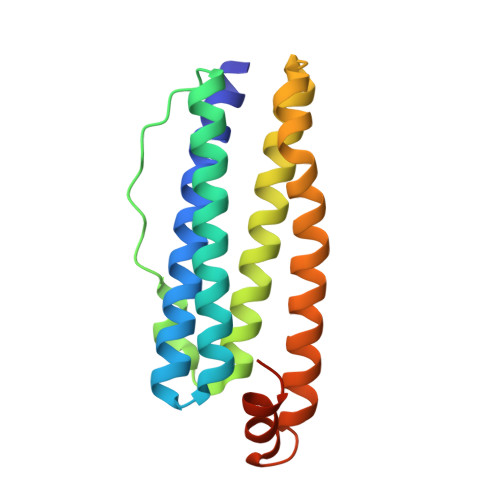Ferritin is used for iron storage in bloom-forming marine pennate diatoms.
Marchetti, A., Parker, M.S., Moccia, L.P., Lin, E.O., Arrieta, A.L., Ribalet, F., Murphy, M.E., Maldonado, M.T., Armbrust, E.V.(2009) Nature 457: 467-470
- PubMed: 19037243
- DOI: https://doi.org/10.1038/nature07539
- Primary Citation of Related Structures:
3E6R, 3E6S - PubMed Abstract:
Primary productivity in 30-40% of the world's oceans is limited by availability of the micronutrient iron. Regions with chronically low iron concentrations are sporadically pulsed with new iron inputs by way of dust or lateral advection from continental margins. Addition of iron to surface waters in these areas induces massive phytoplankton blooms dominated primarily by pennate diatoms. Here we provide evidence that the bloom-forming pennate diatoms Pseudo-nitzschia and Fragilariopsis use the iron-concentrating protein, ferritin, to safely store iron. Ferritin has not been reported previously in any member of the Stramenopiles, a diverse eukaryotic lineage that includes unicellular algae, macroalgae and plant parasites. Phylogenetic analyses suggest that ferritin may have arisen in this small subset of diatoms through a lateral gene transfer. The crystal structure and functional assays of recombinant ferritin derived from Pseudo-nitzschia multiseries reveal a maxi-ferritin that exhibits ferroxidase activity and binds iron. The protein is predicted to be targeted to the chloroplast to control the distribution and storage of iron for proper functioning of the photosynthetic machinery. Abundance of Pseudo-nitzschia ferritin transcripts is regulated by iron nutritional status, and is closely tied to the loss and recovery of photosynthetic competence. Enhanced iron storage with ferritin allows the oceanic diatom Pseudo-nitzschia granii to undergo several more cell divisions in the absence of iron than the comparably sized, oceanic centric diatom Thalassiosira oceanica. Ferritin in pennate diatoms probably contributes to their success in chronically low-iron regions that receive intermittent iron inputs, and provides an explanation for the importance of these organisms in regulating oceanic CO(2) over geological timescales.
Organizational Affiliation:
School of Oceanography, University of Washington, Box 357940, Seattle, Washington 98195, USA.















